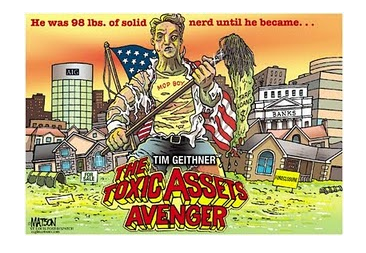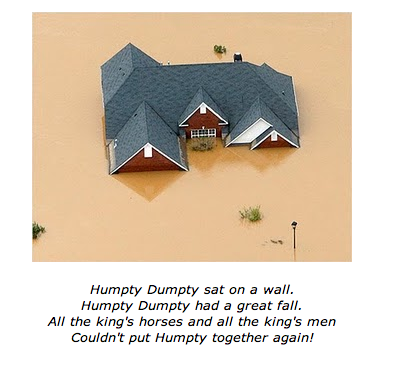HAMP to the Rescue
Courtesy of MIKE WHITNEY writing at CounterPunch
 Last Friday, the Obama administration announced changes to its Home Affordable Modification Program (HAMP) The most significant change is "principal reduction". By reducing the balance on underwater loans, the administration hopes to lower the number of foreclosures which have soared to more than 300,000 per month. This looks like a plan that could work, since most foreclosures are the result of negative equity or unemployment. If the banks and other investors agree to the terms of the program (and it looks like they will) then more homeowners will be able to avoid foreclosure, prices will stabilize, and the recovery will gain momentum. There is one drawback, however, which is moral hazard writ large. The new program rewards the speculators who bet on dodgy investments and who’ll be able to exchange their garbage securitizations for government-guaranteed FHA loans.
Last Friday, the Obama administration announced changes to its Home Affordable Modification Program (HAMP) The most significant change is "principal reduction". By reducing the balance on underwater loans, the administration hopes to lower the number of foreclosures which have soared to more than 300,000 per month. This looks like a plan that could work, since most foreclosures are the result of negative equity or unemployment. If the banks and other investors agree to the terms of the program (and it looks like they will) then more homeowners will be able to avoid foreclosure, prices will stabilize, and the recovery will gain momentum. There is one drawback, however, which is moral hazard writ large. The new program rewards the speculators who bet on dodgy investments and who’ll be able to exchange their garbage securitizations for government-guaranteed FHA loans.
In fact, it looks like that was the real purpose of the program from the very beginning. This is an excerpt from March 30, Bloomberg News:
"Subprime-mortgage securities are rising at an accelerating pace as the U.S. begins to encourage reductions to homeowners’ balances, which may lead to fewer foreclosures and a quicker end to the housing slump….Subprime-loan bonds rated AAA when created in the first half of 2006 climbed 3.2 percent last week to 49.1, the highest since January 2009, according to Markit Group Ltd.
“Senior-ranked bonds tied to borrowers with poor credit will mostly benefit after the Treasury Department said for the first time it would seek to cut the size of mortgages, reducing the likelihood that loan modifications will fail, according to JPMorgan Chase & Co., Morgan Stanley and Barclays Plc. The revised plan also supports the housing market by helping avert more foreclosures, Amherst Securities Group LP analyst Laurie Goodman said." (Bloomberg)
So, it looks like Obama’s modification program has touched-off a gold rush in toxic paper. Subprime securitizations which had been worth next to nothing, are presently the hottest item on Wall Street. Main Street’s loss will, once again, mean windfall profits for Wall Street’s hedge fund managers and brokerage kingpins. It’s a subprime bonanza! A recent interview I had with a Wall Street veteran (anonymous) had this to say on the topic:
"It sounds like the investors in securitizations will be swapping underwater real estate for government-insured paper… I think the scam here is just to provide some cover so the hedge funds and other high net worth individuals can trade their low grade paper for Triple AAA mortgages insured by the FHA at the taxpayer expense."
The administration’s program was concocted by the Treasury and heavily influenced by Wall Street’s favorite son, Timothy Geithner. Just last week, Geithner expressed interest in reviving the moribund securitization model which has been in disrepair since two Bear Stearns hedge funds defaulted in July 2007, setting off the Great Financial Crisis. The Treasury Secretary discovered a way that his investor friends and bankers can recoup their losses by simply reducing the face-value of their toxic loans. This is the main objective of the revamped HAMP program; the rest is merely diversionary gibberish intended to confuse the public.
 So far, the administration’s approach to the housing has been to lower rates, extend the length of the mortgages, modify troubled loans, and create inducements for new homebuyers. But nothing has really worked. Out of 3 to 4 million potential modifications, only 170,000 homeowners have successfully converted into a new mortgage. It’s been a total flop. So now the Treasury has moved on to Plan B and is offering to share in the banks costs ($.10 to $.21 cents on the dollar) for principal reduction. Only homeowners who’ve kept up their payments will be eligible to participate.
So far, the administration’s approach to the housing has been to lower rates, extend the length of the mortgages, modify troubled loans, and create inducements for new homebuyers. But nothing has really worked. Out of 3 to 4 million potential modifications, only 170,000 homeowners have successfully converted into a new mortgage. It’s been a total flop. So now the Treasury has moved on to Plan B and is offering to share in the banks costs ($.10 to $.21 cents on the dollar) for principal reduction. Only homeowners who’ve kept up their payments will be eligible to participate.
No one knows how much the banks and other investors will lose via balance reductions, but the losses are likely to be substantial, perhaps, tens of billions of dollars. Nevertheless, the prospect of exchanging downgraded paper assets for FHA loans is a "no brainer" in a market where future price declines are projected to be in the 10 to 20 per cent range. Better to take the loss at the front-end, and worry about short-term profits later.
It’s also worth noting that the amount of principal that the banks cut is always going to be less than the remaining balance of the mortgage. So, if it looks like a homeowner is headed for foreclosure, the best thing to do is trade the bad paper with Uncle Sam, so he gets stuck with the bigger part of the bill. Once the mortgage is refinanced into an FHA loan, the banks are off the hook. If the homeowner tanks, who cares; it’s the government’s problem.
The rest of the HAMP face-lift is just window dressing; more smoke and mirrors. What’s really going on, is the banks and other financial institutions, that are stuffed with sour-MBS, are getting ready to dump their toxic sludge in the new government landfill, also known as FHA.
Here’s a clip from Housingwire which explains how the program works:
"Under the terms of the voluntary program, lenders will be required to write down at least 10per cent of the mortgage principal for borrowers who are current on their payments…. The principal reduction must bring the new FHA loan to value (LTV) to 97.75per cent and make the new payments account for 31per cent of the borrower’s monthly income. The program also offers incentives to lenders who offer borrowers with second lien mortgages similar principal reduction and refinance options. The maximum allowed LTV of the combined loans is 115per cent ." (Housingwire)
Think of it like this: 31 per cent of a monthly unemployment check is much less than a house payment and even lower than most rental payments. It’s a giveaway to keep people in their homes to slow the rate of foreclosures, and avoid more red ink. This keeps inventory from stacking up, which keeps housing prices artificially high. It currently takes 14 months to complete the foreclosure process, which proves that the banks are deliberately dragging their feet because they can’t take the losses. Until a foreclosure finalizes, the banks can fudge the numbers with "mark-to-fantasy" accounting tricks. But when the transaction is complete, the bank has to write down the loss on its books. And that’s the problem. If they process the foreclosures too fast, their capital cushion will dwindle, and FDIC will shut them down. That’s why they’re stretching out the process until Treasury gets its program up-and-running.
Here’s an example of how the program will work for underwater homeowners:
If the homeowner is current on mortgage payments, they’ll be allowed to refinance into a FHA loan amounting to no more than 115 per cent of the home’s current value. So if the current mortgage is $400,000, but the home is now worth $300,000, the maximum of the new FHA mortgage would be $345,000. The difference between the old and new balance would gradually be forgiven if monthly payments are made for the next three years.
 The process provides ample opportunities for fraud. For example, if the banks manage to wrangle a higher appraisal on the homes, then they can cut their losses significantly. It just requires rigging the system so the appraisal doesn’t reflect the true market price. No problem.
The process provides ample opportunities for fraud. For example, if the banks manage to wrangle a higher appraisal on the homes, then they can cut their losses significantly. It just requires rigging the system so the appraisal doesn’t reflect the true market price. No problem.
The program also allows homeowners with poor credit scores (FICOs in the 500s) to convert into FHA loans. That means more losses for taxpayers.
And — as stated above — the borrower will be able to secure a FHA-guaranteed mortgage in the amount of 115 percent of the value of the house. (15per cent more than the current value of the house) This flies in the face of everything we have learned from the subprime crisis, which is that the main driver of foreclosures is the lack of equity. In other words, when people who have no equity,(no material stake in the home, like a down-payment) they tend to default faster than any other category of borrower. The Treasury is bent on repeating the mistakes of the past.
Nearly 25 per cent of U.S. mortgage holders (11.3 million households) are currently underwater on their loans. Almost 6 million are behind on payments or in some stage of default. Unemployment is nearly 10 percent, underemployment is 20 percent (according to Gallup) and, according to many experts, the banks are holding another another 3 to 4 months of "shadow inventory" off the books. Realistically, housing could be in the doldrums for another 5 or 10 years. We need people at Treasury who take the problem seriously and not bank lobbyists and industry agents who merely go from one stealth bailout to the next.
In a recent interview with NPR’s Robert Seigel, the Big Picture’s investment blogger, Barry Ritholtz offered his views on what should be done next, although many readers will likely find his solutions unpalatable. Here’s what he said:
"All these programs seem to be geared to do two things. First, they’re giant giveaways to the big banks. These are designed to prevent banks from actually having to take the full foreclosure write-down right now….
“From a broad perspective, you’re keeping (people) in a house that they can’t afford, and they’d be much better off going to a place that leaves them a little spare change in their pocket, as opposed to just draining everything they have to make those payments….
“If you want to help the people who are in these situations (foreclosure) what you could do is offer them move-out money. Instead of giving $14 billion in additional bailout money to the banks for these programs, facilitate a short sale, give them $1,000 to get a mover, pick up and move across town. There are a lot more effective ways to spend $14 billion than essentially rewarding the banks that were just so reckless and irresponsible. It just doesn’t make any sense." ("Financial Blogger On Ethics Of Mortgage Modification", NPR)
Make no mistake, Obama’s revamped HAMP program will produce better results than the earlier versions, but its costs will be substantial and it won’t fix the underlying problem. Housing prices need to fall to increase demand, homeowners need to be realistic about what they can afford in a post-bubble era, and government regulators need to shut down underwater banks that are lying about the condition of their balance sheets. The last thing we need, is another opaque government program, loaded with glitzy inducements and PR hype, that just kicks the can down the road while lavishing generous subsidies on undercapitalized megabanks.
All Artwork by Jr. Deputy Accountant


